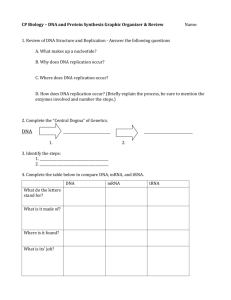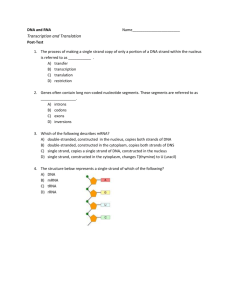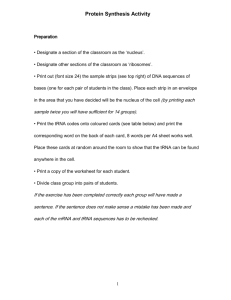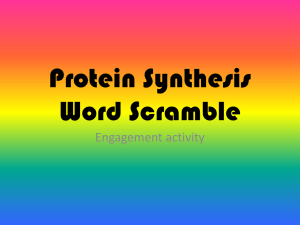DNA and protein synthesis
advertisement
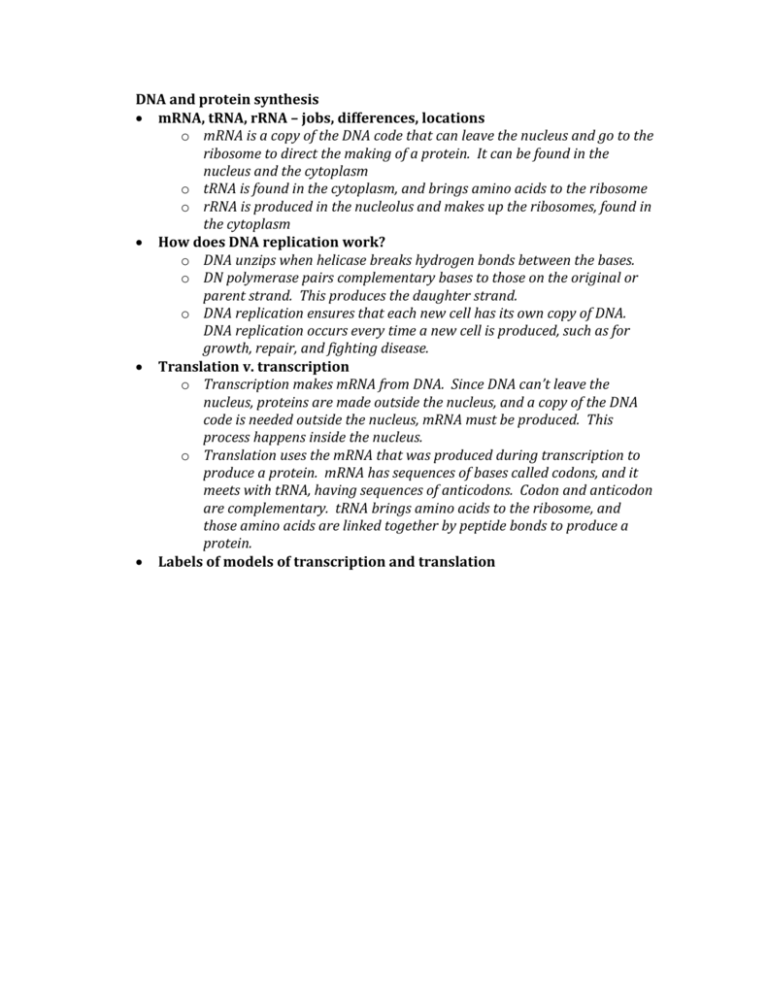
DNA and protein synthesis mRNA, tRNA, rRNA – jobs, differences, locations o mRNA is a copy of the DNA code that can leave the nucleus and go to the ribosome to direct the making of a protein. It can be found in the nucleus and the cytoplasm o tRNA is found in the cytoplasm, and brings amino acids to the ribosome o rRNA is produced in the nucleolus and makes up the ribosomes, found in the cytoplasm How does DNA replication work? o DNA unzips when helicase breaks hydrogen bonds between the bases. o DN polymerase pairs complementary bases to those on the original or parent strand. This produces the daughter strand. o DNA replication ensures that each new cell has its own copy of DNA. DNA replication occurs every time a new cell is produced, such as for growth, repair, and fighting disease. Translation v. transcription o Transcription makes mRNA from DNA. Since DNA can’t leave the nucleus, proteins are made outside the nucleus, and a copy of the DNA code is needed outside the nucleus, mRNA must be produced. This process happens inside the nucleus. o Translation uses the mRNA that was produced during transcription to produce a protein. mRNA has sequences of bases called codons, and it meets with tRNA, having sequences of anticodons. Codon and anticodon are complementary. tRNA brings amino acids to the ribosome, and those amino acids are linked together by peptide bonds to produce a protein. Labels of models of transcription and translation o When does protein synthesis occur (in comparison with mitosis) o Protein synthesis occurs anytime the body needs to make new body tissue, new organelles, new enzymes, new antibodies, etc. It happens during the G1 stage of interphase. Then, when new cells are created during cell division, there are enough materials to divide the cytoplasm in two to make a new cell. What is a nucleotide o A nucleotide is made of a phosphate, sugar, and a base. DNA and RNA are both made of nucleotides – DNA has two strands of them, and RNA has one strand. Sequence of genes to proteins o DNA is copied into mRNA through the process of transcription, which is followed by translation, during which the mRNA code is converted into a protein Codon v. anticodon o Codons are found on mRNA, anticodons are found on tRNA. Codons and anticodons are complementary Hershey chase experiment o They set up 2 experiments – one in which DNA was labeled with radioactive phosphorous, the other in which the protein was labeled with radioactive sulfur. The DNA or protein of the virus was labeled, then allowed to infect the bacteria (viruses infect bacteria by injecting their genetic information into a bacteria cell). Once the viruses had infected the bacteria, they separated the viruses and bacteria, and looked to see whether there was radioactive phosphorous or sulfur inside the bacteria. Since they found radioactive phosphorous inside, they concluded that DNA, and not protein, was the genetic material found in chromosomes.
